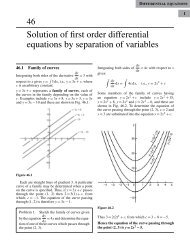vector
Create successful ePaper yourself
Turn your PDF publications into a flip-book with our unique Google optimized e-Paper software.
398 Vectors<br />
5. Find the directional derivative of the scalar function of (x, y, z) = xyz in the direction of the outer<br />
normal to the surface z = xy at the point (3, 1, 3).<br />
Ans.<br />
27<br />
11<br />
6. The temperature of the points in space is given by T(x, y, z) = x 2 + y 2 – z. A mosquito located at<br />
(1, 1, 2) desires to fly in such a direction that it will get warm as soon as possible. In what direction<br />
should it move?<br />
Ans.<br />
1 (2 i <br />
2 j <br />
<br />
k )<br />
3<br />
7. If (x, y, z) = 3xz 2 y – y 3 z 2 , find grad at the point (1, –2, –1) Ans.<br />
<br />
(16i 9j 4 k)<br />
8. Find a unit <strong>vector</strong> normal to the surface x 2 y + 2xz = 4 at the point (2, –2, 3).<br />
1<br />
Ans. ( i 2 j 2 k<br />
<br />
)<br />
3<br />
9. What is the greatest rate of increase of the function u = xyz 2 at the point (1, 0, 3)? Ans. 9<br />
10. If is the acute angle between the surfaces xyz 2 = 3x + z 2 and 3x 2 – y 2 + 2z = 1 at the point<br />
(1, –2, 1) show that cos = 3/7 6 .<br />
11. Find the values of constants a, b, c so that the maximum value of the directional directive of<br />
= axy 2 + byz + cz 2 x 3 at (1, 2, –1) has a maximum magnitude 64 in the direction parallel to the<br />
axis of z. Ans. a = b, b = 24, c = –8<br />
12. Find the values of and µ so that surfaces x 2 – µ y z = ( + 2)x and 4 x 2 y + z 3 = 4 intersect<br />
orthogonally at the point (1, –1, 2). Ans. = 9 , 1<br />
2 <br />
13. The position <strong>vector</strong> of a particle at time t is R = cos (t – 1) i + sinh (t – 1) j + at 2 k. If at t = 1,<br />
the acceleration of the particle be perpendicular to its position <strong>vector</strong>, then a is equal to<br />
1<br />
(a) 0 (b) 1 (c)<br />
2<br />
5.29 DIVERGENCE OF A VECTOR FUNCTION<br />
The divergence of a <strong>vector</strong> point function F <br />
<br />
(d)<br />
1<br />
2<br />
(AMIETE, Dec. 2009) Ans. (d)<br />
is denoted by div F and is defined as below.<br />
Let F = Fi 1 F 2 j Fk 3<br />
div F1 F2 F F = . F i j k ( iF1 jF2 kF3)<br />
= 3<br />
x y z<br />
x y z<br />
It is evident that div F is scalar function.<br />
5.30 PHYSICAL INTERPRETATION OF DIVERGENCE<br />
Let us consider the case of a fluid flow. Consider a small rectangular parallelopiped of<br />
dimensions dx, dy, dz parallel to x,y and z axes respectively.<br />
<br />
Let V Vx i Vy j Vz<br />
k<br />
be the velocity of the<br />
fluid at P(x, y, z).<br />
Mass of fluid flowing in through the face ABCD in unit time<br />
= Velocity × Area of the face = V x<br />
(dy dz )<br />
Mass of fluid flowing out across the face PQRS per unit time<br />
= V x<br />
(x + dx) (dy dz)<br />
Vx<br />
<br />
= Vx<br />
dx ( dydz)<br />
x<br />
<br />
<br />
Y<br />
Net decrease in mass of fluid in the parallelopiped<br />
corresponding to the flow along x-axis per unit time<br />
O<br />
Z<br />
A<br />
C<br />
D<br />
dz<br />
V x B<br />
S<br />
P<br />
R<br />
Q<br />
X










